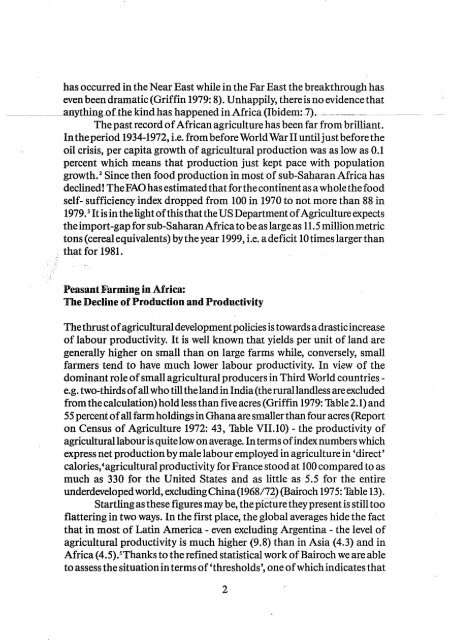Create successful ePaper yourself
Turn your PDF publications into a flip-book with our unique Google optimized e-Paper software.
has occurred in the Near East while in the Far East the breakthrough has<br />
even been dramatic (Griffin 1979: 8). Unhappily, there is no evidence that<br />
anything_ofthekindhashappened inAfrica (Ibidem: 7).<br />
The past record of African agriculture has been far from brilliant.<br />
In the period 1934-1972, i.e. from before World War II untiljust before the<br />
oil crisis, per capita growth of agricultural production was as low as 0.1<br />
percent which means that production just kept pace with population<br />
growth. 2 Since then food production in most of sub-Saharan Africa has<br />
declined! TheFAO has estimated thatforthe continent as a whole the food<br />
self- sufficiency index dropped from 100 in 1970 to not more than 88 in<br />
1979. 3 It is in the light ofthis that the US Department of Agriculture expects<br />
the import-gap for sub-Saharan Africa to be as large as 11.5 million metric<br />
tons (cereal equivalents) by the year 1999, i.e. a deficit 10 times larger than<br />
that for 1981.<br />
Peasant Farming in Africa:<br />
The Decline of Production and Productivity<br />
The thrust of agricultural development policies is towards a drastic increase<br />
of labour productivity. It is well known that yields per unit of land are<br />
generally higher on small than on large farms while, conversely, small<br />
farmers tend to have much lower labour productivity. In vi.::w of the<br />
dominant role of small agricultural producers in Third World countries -<br />
e.g. two-thirds of all who till the land in India (the rural landless are excluded<br />
from the calculation) hold less than five acres (Griffin 1979: Table 2.1) and<br />
55 percent of all farm holdings in Ghana are smaller than four acres (Report<br />
on Census of Agriculture 1972: 43, Table VII.lO) - the productivity of<br />
agricultural labour is quite low on average. In terms of index numbers which<br />
express net production by male labour employed in agriculture in 'direct'<br />
calories,4agricultural productivity for France stood at 100 compared to as<br />
much as 330 for the United States and as little as 5.5 for the entire<br />
underdeveloped world, excluding China (1968/72) (Bairoch 1975: Table 13).<br />
Startling as these figures may be, the picture they present is still too<br />
flattering in two ways. In the first place, the global averages hide the fact<br />
that in most of Latin America - even excluding Argentina - the level of<br />
agricultural productivity is much higher (9.8) than in Asia (4.3) and in<br />
Africa (4.5).sThanks to the refined statistical work of Bairoch we are able<br />
to assess the situation in terms of 'thresholds', one of which indicates that<br />
2
















